| ID |
Date |
Author |
Type |
Category |
Subject |
|
457
|
Wed Oct 9 13:52:31 2024 |
Tyler | Update | TCS | RIN Update 10/09/2024 |
I tried adjusting the gain settings on the photodetectors to check if this would help improve the RIN spectra measurements. Overall, it doesn't look like it does, and if anything, looks worse. I assume this is so because as the gain is lowered, the amount of detectable signal from the FROSTI becomes smaller and smaller. |
| Attachment 1: RIN_plots_CH0.pdf
|

|
|
470
|
Wed Nov 13 14:03:32 2024 |
Tyler | Update | Electronics | RIN Update |
| [Tyler]
We've added two low-pass filters in hopes of reducing any potential aliasing that may be introducing additional noise into the power spectra for the RIN measurements. It still looks like the noise levels are too high. Attached below are some recent measurements taken with the FROSTI powered on and off.
|
| Attachment 1: IMG_0463.jpg
|
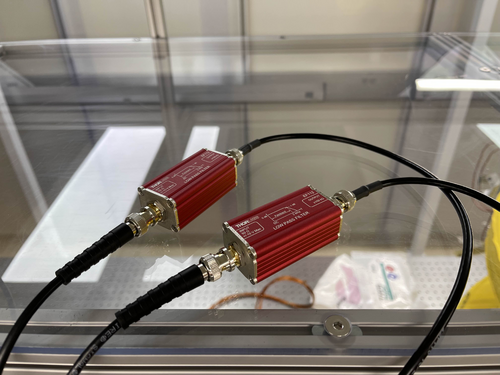
|
| Attachment 2: CH0_CH1_ASDs.pdf
|

|
|
477
|
Wed Nov 20 12:59:37 2024 |
Tyler | Update | Electronics | RIN Update |
| I went ahead and compared the noise spectrum of the ADC to those of the photodetectors with the FROSTI on and off. As discussed last meeting, it looks like the measurements with the Red Pitaya (RP) are limited by the ADC noise floor. Another avenue to explore in this measurement could be switching to the cymac ADCs. |
| Attachment 1: ASD_plots.pdf
|

|
|
479
|
Wed Nov 27 13:48:01 2024 |
Tyler | Update | Electronics | RIN Update |
| [Tyler]
I downgraded the Red Pitaya back to OS 2.00-18 due to runtime errors during measurement. Once I did this, the device appeared to work much better than it has the last few weeks. First, it appears we can actually see the cutoff of the added low-pass filters that were added in to the RIN setup. Second, there does appear to be a difference again between the FROSTI ON state versus the dark state (i.e. FROSTI OFF). A long measurement of the ADC noise floor in the current configuration still needs to be recorded, but it does appear that the recent highlighted issues with the Red Pitaya have been solved.
|
| Attachment 1: New_ASD_plots.pdf
|

|
|
635
|
Tue Aug 26 12:45:41 2025 |
Christina, Ma, Tyler | Update | CDS | RIN Update |
| Slides |
|
531
|
Tue Mar 4 10:28:58 2025 |
Tyler | Update | TCS | RIN Plot Updates |
|
| Attachment 1: Dark_bin_veto.pdf
|

|
| Attachment 2: Mock_final_plot_inst.pdf
|

|
|
422
|
Mon Aug 12 16:24:34 2024 |
Tyler | Update | Cleanroom | RIN Measurement Update 1 |
| [Tyler]
For some preliminary tests, I moved the IR photodetectors outside of the cleanroom and onto the other optical table. The basic goal was to obtain a signal from both photodetectors. To achieve this, one of the heater cartridges used for early FLIR measurements months ago was hooked up to a power supply (PS). The PS was set to supply 0.20 A with a voltage of 2.8 V; the corresponding power is thus 0.56 W. With this, I was able to measure a signal using the Red Pitaya, the device that will be used for following RIN measurements.
| Quote: |
| [Tyler]
I have begun moving parts into the cleanroom for the upcoming FROSTI RIN tests that will be conducted within the next few weeks. While waiting for the rest of the equipment to arrive to perform the full-scale tests, I have additionally moved the FROSTI under the shelf above the optical table, where it will stay for the meantime. As always, please use caution when in the cleanroom. Aside from the FROSTI, the IR photodetectors that will be used for the test are delicate and costly to replace.
|
|
| Attachment 1: Basic_setup.jpg
|
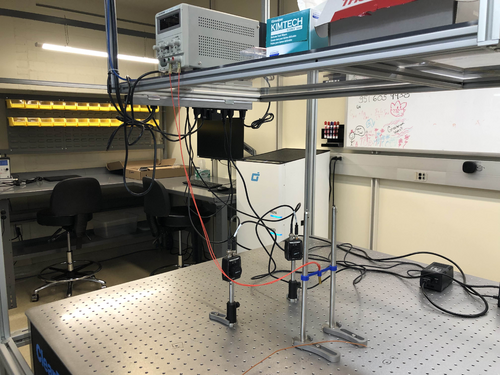
|
| Attachment 2: RP.jpg
|
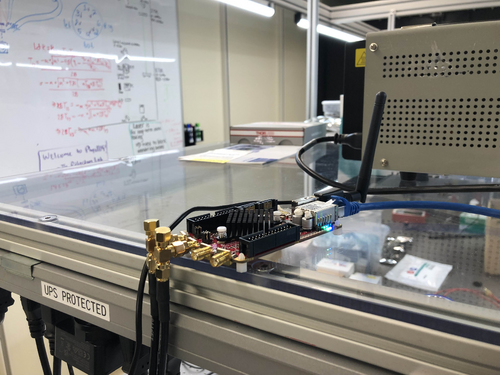
|
|
417
|
Mon Jul 29 14:30:16 2024 |
Tyler | Update | Cleanroom | RIN Measurement Set-up |
| [Tyler]
I have begun moving parts into the cleanroom for the upcoming FROSTI RIN tests that will be conducted within the next few weeks. While waiting for the rest of the equipment to arrive to perform the full-scale tests, I have additionally moved the FROSTI under the shelf above the optical table, where it will stay for the meantime. As always, please use caution when in the cleanroom. Aside from the FROSTI, the IR photodetectors that will be used for the test are delicate and costly to replace.
|
| Attachment 1: RIN_FROSTI.jpg
|
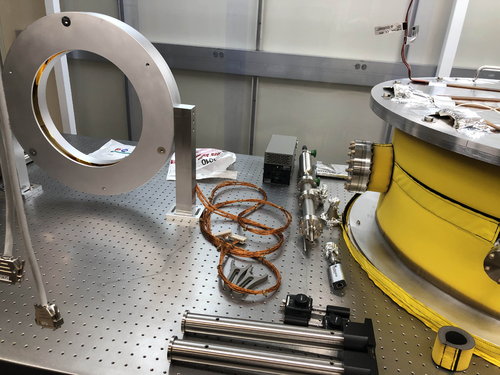
|
|
637
|
Tue Sep 2 11:53:34 2025 |
Tyler | Update | TCS | RIN Infrastructure Update (09/02/2025) |
| [Ma, Tyler]
Below are slides discussing RIN infrastructural updates related to the CyMAC.
Slides
|
|
648
|
Tue Sep 23 13:10:07 2025 |
Tyler | Update | TCS | RH O6 Update 09/23/25 |
| Slides |
|
642
|
Tue Sep 9 12:06:38 2025 |
Tyler | Update | TCS | RH O6 Update |
| Slides |
|
627
|
Tue Aug 12 13:28:00 2025 |
Tyler | Update | TCS | RH Fenicsx v. HV |
|
| Attachment 1: Profile_comparison.png
|
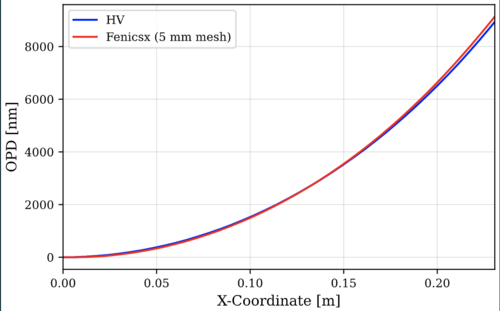
|
| Attachment 2: 1W_diff.png
|
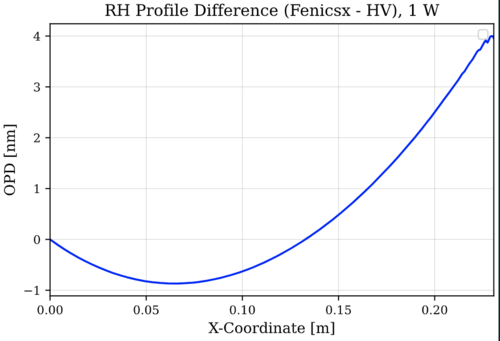
|
| Attachment 3: 50W_diff.png
|
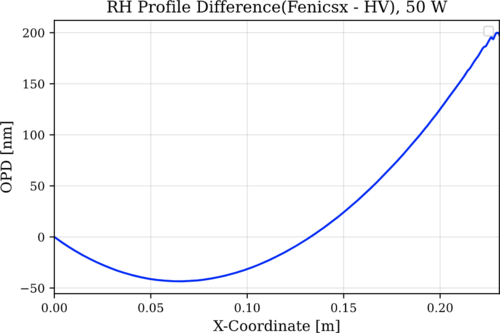
|
|
401
|
Thu Jul 11 15:53:39 2024 |
Luke | Update | VAC | RGA line upgrade |
[ Luke, Jon ]
Started work at 11:00
As mentioned in my previous post the RGA was not clearing the table because of a tilt in the cross. So I removed the 90 deg elbow, loosened the bolt securing the Tee to the ZLR, and removed the cross from the gate valve. I then spun around the Tee on the bottom so that the cal leak would be pointing in the right direction and connected the rotating 2.75" flange of the cross to the gate valve. I then added the small turbo pump to the top of the cross.
Then with the help of Dr. Richardson, we made some adjustments to how the Tee was oriented with respect to the cross and how the cross was with respect to the table. So that the cal leak and RGA would fit on the table. After that we made some changes to the bolting of the ZLR to reducing cross replacing the 2.00" bolts and nuts with 1.75" bolts and nut plates. We did face some difficulty with half of the 2.00" bolts which required a bit of torque to get them out.
Finished work at 2:20
Things to do:
Before we start pumping down the system again Dr. Richardson wanted two other changes to be made. To replace the 2.75" to 1.33" conical reducer with a zero length reducer. He also wants the bolts that hold the main turbo pump to be replaced with nut plates.
I plan on starting this work on Friday (7/12) before pumping down over the weekend |
| Attachment 1: image_2024-07-11_154630323.png
|
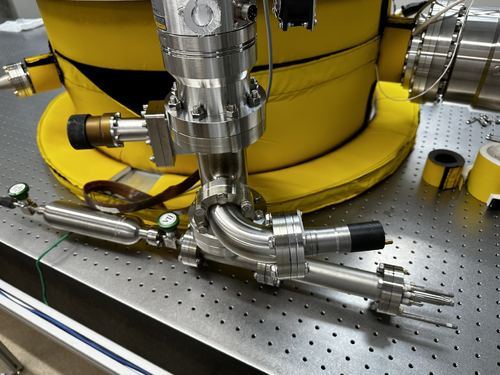
|
| Attachment 2: image_2024-07-11_154818191.png
|
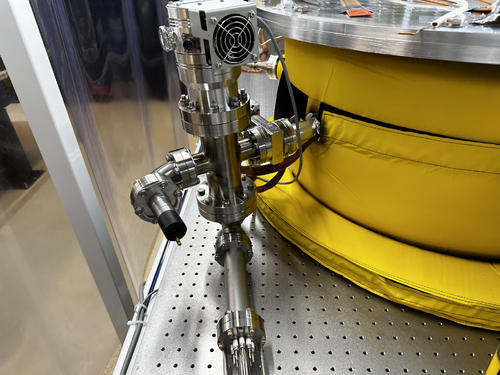
|
| Attachment 3: image_2024-07-11_154902840.png
|
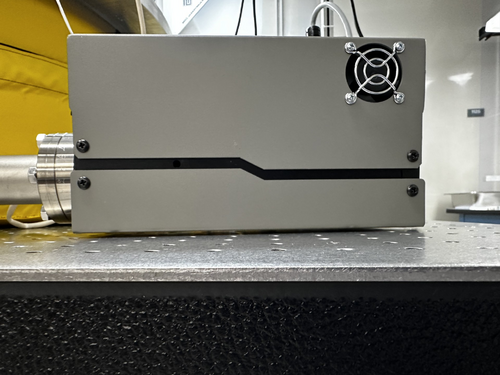
|
|
427
|
Fri Aug 23 16:08:32 2024 |
Luke | Update | VAC | RGA line leak testing |
[Luke, Luis, Jon, Tyler]
On the 22nd Dr. Richardson showed Luis, Tyler and I how to preform a leak test with the RGA. We did the initiall test and found a few leaks two were particuarly bad highlighted in orenge below. To try and remidy this we planned on replacing the copper gaskests on the leaking flanges. We then began taking the two problem flanges off, but seven of the eight bolts holding on the turbo pump were over tightened and had seized. So after we got them off we postponed the rest of the work to the next day.
On the 23nd Luis and I reattached the badly leaking flanges with new copper gaskets. We then preformed the Helium leak test with the RGA. As seen in the table below we weren't able to majorly changed the leaks in the two flanges.
| Connection |
Initial |
After disassembly |
| Tee - RGA |
3.1e-9 -> 2.4e-9 |
9.2e-9 |
| Tee - Cal leak |
Low |
Low |
| Tee - ZLR (2.75"-4.5") |
Low |
9.2e-9 |
| ZLR (2.75"-4.5") - Reducing Cross |
2.1e-8 -> 1.9e-8 |
3.6e-8 -> 9.3e-9 |
| Cross - Elbow |
Low |
1.2e-9 |
| Elbow - Pressure sensor |
Low |
2.9e-9 |
| Cross - Turbo pump (small) |
2.1e-8 -> 3.1e-8 |
6.9e-8 -> 2.2e-8 |
| Cross - Gate valve |
Low |
Low |
| Gate valve - Port |
2.4e-9 -> 2.2e-9 |
1.2e-9 |
| Port - ZLR (6.0"-8") |
1.1e-9 |
N/A |
| ZLR (6.0"-8") - Turbo pump (large) |
Low |
N/A |
| Port - Pressure sensor |
Low |
N/A |
| Port - Up to air valve |
Low |
N/A |
| Port - Blank |
Low |
N/A |
| Port - Feed though port |
Low |
N/A |
| Lid |
Low |
N/A |
|
|
429
|
Tue Aug 27 15:01:26 2024 |
Luke | Update | VAC | RGA line leak testing |
[Luke, Tyler]
On the 27th Tyler and I ran the RGA leak test again with the electron multiplier on. These were the leaks we measured. The chamber's overall pressure was at ~6e-8 torr.
| Connection |
Leak rate (torr) |
| Tee - RGA |
3.92e-11 (very low) |
| Tee - Cal leak |
4.77e-11 (very low) |
| Tee - ZLR (2.75"-4.5") |
4.97e-11 (very low) |
| ZLR (2.75"-4.5") - Reducing Cross |
2.45e-9 (low) |
| Cross - Elbow |
7.36e-11 (very low) |
| Elbow - Pressure sensor |
2.36e-11 (very low) |
| Cross - Turbo pump (small) |
8.07e-9 (lowish) |
| Cross - Gate valve |
4.02e-11 (very low) |
| Gate valve - Port |
2.27e-9 (low) |
| Port - ZLR (6.0"-8") |
1.11e-9 (low) |
| ZLR (6.0"-8") - Turbo pump (large) |
1.00e-10 (very low) |
| Port - Pressure sensor |
1.05e-10 (very low) |
| Port - Up to air valve |
1.08e-11 (very low) |
| Port - Blank |
5.58e-10 (very low) |
| Port - Feed though port |
1.21e-11 (very low) |
| Lid |
1.11e-11 (very low) |
|
|
400
|
Wed Jul 10 17:31:07 2024 |
Luke | Update | VAC | RGA line disassembly and upgrade |
[ Luke, Cynthia, Michael, Xuesi, Anthony ]
Started work around 12:45
We vented the chamber first and once it reached atmospheric pressure we started taking apart the RGA line.
We removed the parts in this order: Calibrated leak, RGA, Pressure gauge, 2.75" Blank on Tee, 2.75" Tee, all 1.33" Blanks on the cube, 4.5" feed through port, and finally the cube. Everything went smoothly after every part was taken off we covered the ends in Aluminum foil to maintain cleanliness.
We then started the assembly of the new line. The parts were added in this order: Reducing cross, ZLR, Tee, Cal leak, RGA, 90 deg Elbow, and Pressure sensor.
We left off the Turbo pump as of now because we weren't able to find a 1" post not in use and we didn't want to put too much weight on the cross. We also noticed that the RGA might not fit on its probes because of a slight tilt to the cross and by extension the Tee. If this ends up being a problem we might need to remove all the parts connected to the cross so that we can reposition it so that the 2.75" rotating flange is connected to the gate valve.
Ended work around 4:00 |
| Attachment 1: image_2024-07-10_172112210.png
|
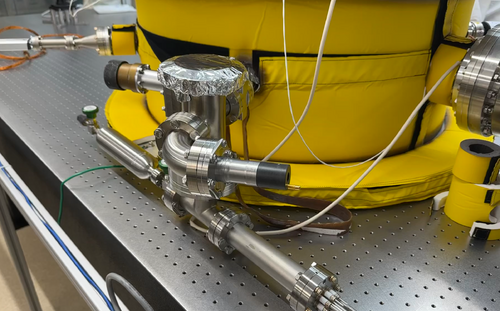
|
| Attachment 2: image_2024-07-10_172431863.png
|
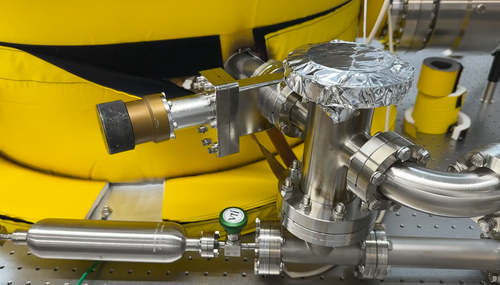
|
| Attachment 3: image_2024-07-10_172603090.png
|
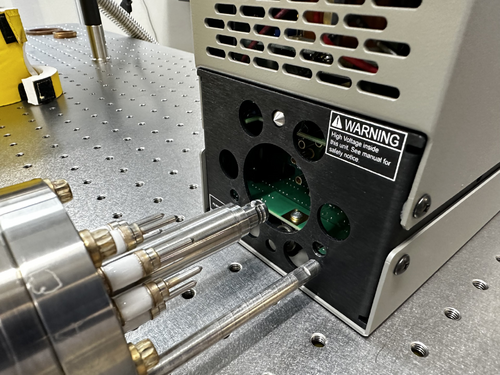
|
| Attachment 4: image_2024-07-10_172823966.png
|
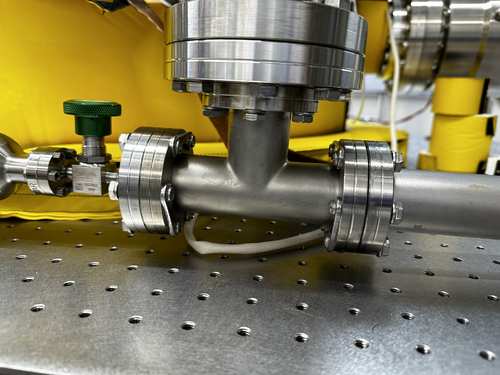
|
|
261
|
Fri Nov 10 08:32:34 2023 |
Jon | Update | VAC | RGA experiments |
I ran a 3-minute degas cycle of the RGA filament for the first time yesterday (in this process, the filament gets very hot in order to "boil off" settled particulate). I was surprised to see the pressure (of not just the RGA volume, but also the main volume) rise from 2e-8 to 5e-6 torr.
This observation, plus the rise in pressure seen every time the filament is activated for an RGA scan, indicates we have significant particulate settling on the RGA filament. This may be systematically biasing RGA scans taken within a short time (~15 minutes) of turning on the filament.
I have two ideas to reduce particulate on the RGA. However, before implementing these, I first want to consult with the vacuum experts at LIGO Lab.
- Run a second RGA degas cycle, but next time with the main volume valved off with only the RGA volume being pumped (through the bypass line). This will prevent "boiled off" particulate from entering the main chamber and will also increase the pumping rate for the RGA volume, reducing the amount of particulate that resettles on the RGA filament.
- I also noticed that the SRS manual states that the filament is designed to be long-lived and it is recommended to leave it on any time the RGA is on. By leaving the filament on all the time (i.e., hot), we could reduce the amount of particulate that is evidently settling on it between scans. I am checking whether LIGO Lab does this in their own chambers.
|
|
266
|
Tue Nov 14 17:21:40 2023 |
Jon | Update | VAC | RGA best practices |
As a follow up ELOG 261, I have received advice from one of the vacuum experts at LIGO Hanford on best practices for our RGA:
-
For future RGA degassing, definitely keep the main volume isolated, since it could contaminate the main volume with everything that just got cooked off of the filament. So the procedure should be to (i) close both gate valves, (ii) ensure the angle valve on the bypass line is open, (iii) initiate the degas cycle on the RGA, (iv) pump the RGA volume through the bypass line, until its pressure returns to its pre-degas level.
-
Repeated degassing of the filament will definitely wear it down much faster, so do this operation sparingly.
-
As long as the pressure of the RGA volume is in the UHV range (~1e-9 torr), best practice is to leave the filament on. This keeps it hot which helps prevent particulate from settling on it. However the electron multiplier should stay off when not actively taking scans, as it will wear down if left on all the time.
|
|
487
|
Wed Dec 11 16:06:05 2024 |
Luis | Update | VAC | RGA Status |
[Luis]
I rebooted Spica and I was able to connect the RGA again. After Connecting the RGA, I left the filament on. |
|
96
|
Wed May 10 10:49:34 2023 |
Aiden | Update | General | RGA Software |
| [Aiden, Cao]
Went over how to use the RGA software, how to change the graph units, scaling and mass detection. Also went over how to remove the RGA from the vacuum system as well as procedure for turning it on. |
|
440
|
Mon Sep 16 13:51:23 2024 |
Luis Martin | Update | VAC | RGA Scans |
|
[Luis, Luke}
Three RGA scans were taken. The improvement in the amount of HC in the vacuum is visible across the different measurements. Images are attached.
|
| Attachment 1: 2024-09-11_PostBake1_ArO.png
|
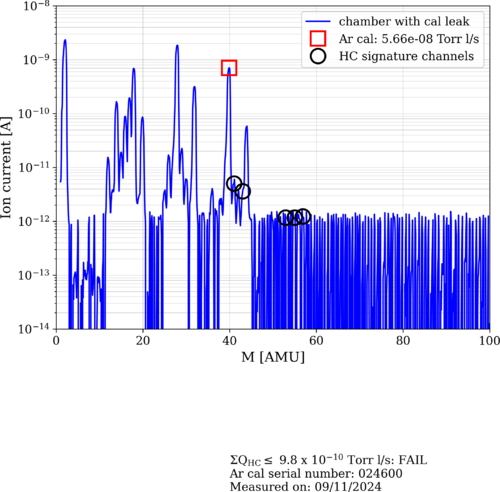
|
| Attachment 2: 2024-09-13_PostBake1_ArO.png
|
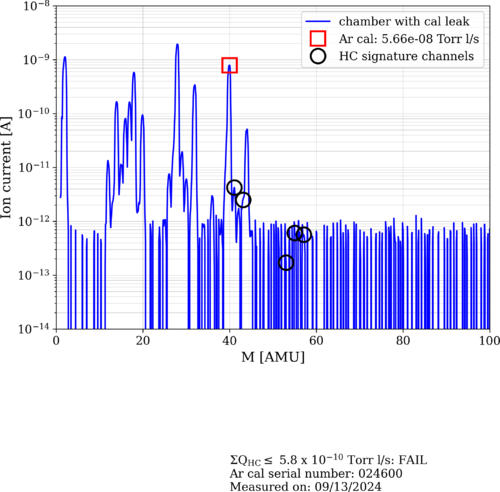
|
| Attachment 3: 2024-09-16_PostBake1_ArO.png
|
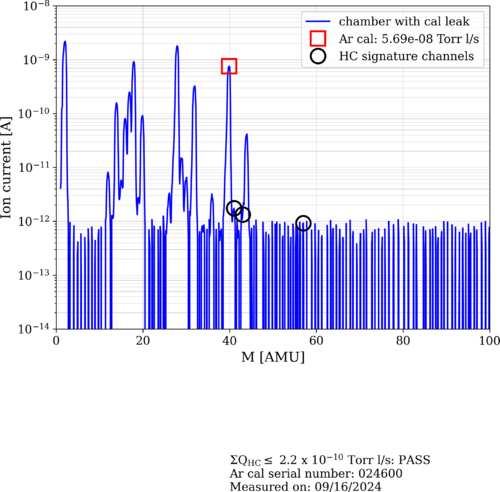
|
|
448
|
Wed Sep 25 09:06:09 2024 |
Luis Martin | Update | VAC | RGA Scans |
|
RGA Scan Comparison
The following images compare the RGA scans from 9/23/24, after the first bake with the new vacuum system, with those from 3/14/24, after bake 12 with the old system.
The first image shows a graph of the raw data and includes the calibrated leak for both curves. As we can see, our new system meets LIGO standards of cleanliness.
The second graph contains the plot of the normalized data.
|
| Attachment 1: 24overlay.png
|
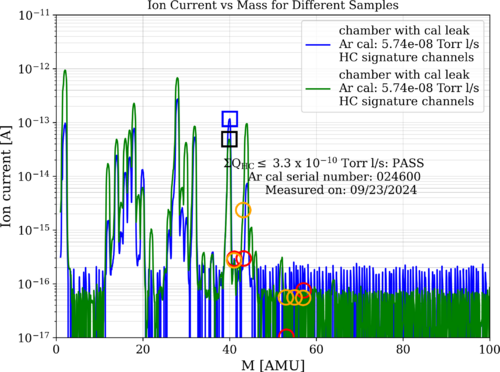
|
| Attachment 2: 24overlayNormalized.png
|
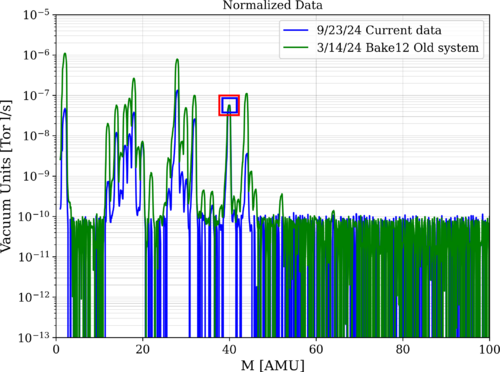
|
|
488
|
Thu Dec 12 13:06:39 2024 |
Luis | Update | VAC | RGA Scan and vacuum system updates |
| [Luis, Luke]
RGA Volume: T = 21°C, P = 1.74e-9 Torr
Main Volume: T = 22°C, P = 5.60e-9 Torr
We performed an RGA scan of the system. As we can see, we met cleanliness standards. The S/N ratio was roughly calculated and it is about 100. I will update the code to make this calculation and to have it displayed on the plot in the next scan we perform.
After this, we closed the RGA to the main volume valve, degassed the filament, and after the pressure came down to what it was initially, we reopened the valve. After the degassing, we took another scan. The overlaid plots are attached below.
The noise floor seemed to be about the same. I will take another scan tomorrow to verify whether it was the same or if the system just needed a little more time to be completely clean. |
| Attachment 1: 2024-12-12_PostBake2_ArC.png
|
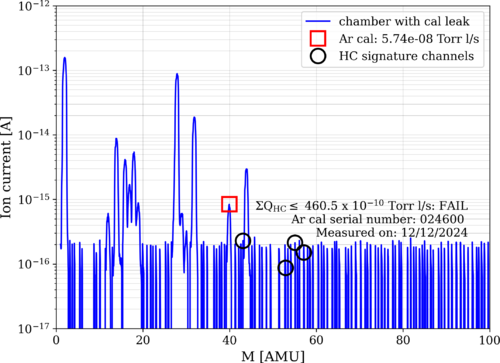
|
| Attachment 2: 2024-12-12_PostBake2_ArO_overlay.png
|
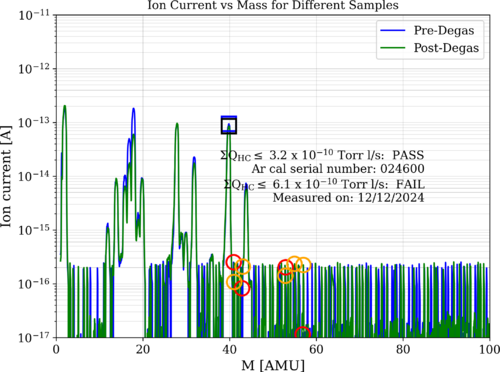
|
|
485
|
Thu Dec 5 10:31:13 2024 |
Luis | Update | VAC | RGA Scan and RGA updates |
|
[Luis,Shane]
An RGA scan was taken on Dec 4th. The results are attached at the end of the e-log. As we can see, the scan results are under the allowed limits. After the scan, Shane and I worked on the vacuum connections. The filament was turned off, and the RGA was disconnected from Spica.
After we finished the tests, we reconnected the RGA and attempted to turn the filament back on. However, the program was unable to connect to the instrument. We checked for any loose connections but did not find anything. The RGA connection needs to be troubleshot and fixed.
|
| Attachment 1: 2024-12-04_PostBake2_ArO.png
|
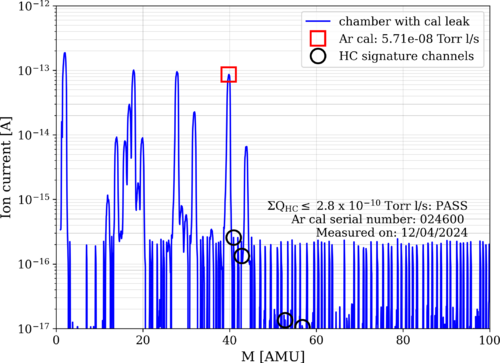
|
|
573
|
Thu May 8 17:41:56 2025 |
Luis | Update | VAC | RGA Scan Post Bake |
[Ma, Luis]
After taking the RGA scans of the new system, here are the results of the raw and normalized data.We can see that in the post baked system the He peak is way lower, and the peaks around 20AMU are also significantly lower. |
| Attachment 1: 2025-4-29_HeaterElement-Bake1_ArO_overlay.png
|
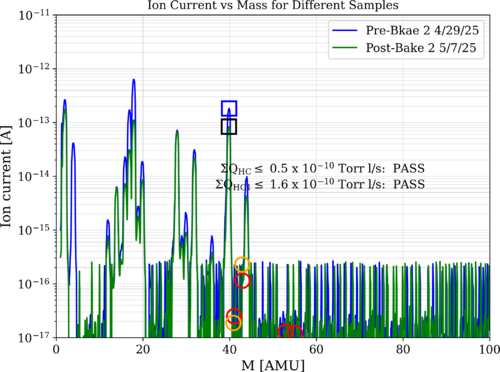
|
| Attachment 2: 2025-4-29_HeaterElement-Bake1_ArO_overlayNormalized.png
|

|
|
459
|
Wed Oct 16 13:58:59 2024 |
Luis Martin | Update | VAC | RGA Scan |
The following figure displays data acquired on 10/09, and it shows that we are no longer below the cleanliness standard. Also, the system's pressure went up to 1.9x10-8 Torr (approximately 7x10-9 Torr previously). This might be due to a leak somewhere in the system. More tests will be performed later. |
| Attachment 1: 2024-10-09_PostBake1_ArO.png
|
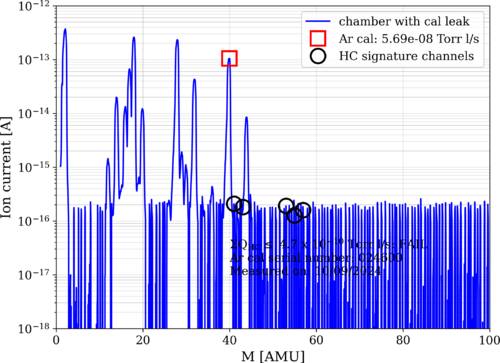
|
|
463
|
Wed Oct 23 12:08:36 2024 |
Luis Martin | Update | VAC | RGA Scan |
[Luke, Luis, Mary, Ma]
On 10/22/24 Luke, Ma, Mary and myself ran a RGA scan, the results are displayed below. The overall pressure of the vacuum was 2.0e-8 and the temperature readings were 26C for the RGA and 25C for the main volume.
As we can see, the vacuum is passing cleanliness standards again. |
| Attachment 1: 2024-10-22_PostBake1_ArO.png
|
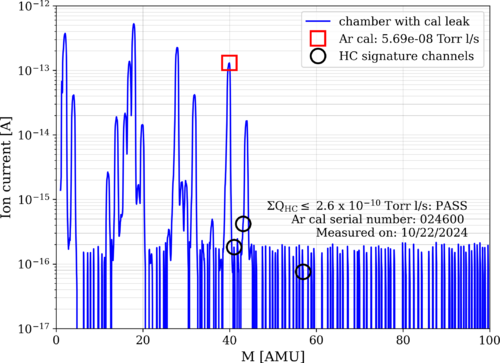
|
|
519
|
Thu Feb 20 17:07:36 2025 |
Luis | Update | VAC | RGA Scan |
| [Ma, Luis]
February 20, 2025 - 3:30 PM
Ma performed an RGA scan with the vacuum system containing the heater elements. The results are attached below.
|
Pressure (Torr) |
Temperature (°C) |
| RGA Volume |
1.87× 10⁻⁹ |
23 |
| Main Volume |
5.70 × 10⁻⁹ |
23 |
As we can see, we are not yet under cleanliness standards. The passing threshold is 4 × 10⁻¹⁰, we are very close to it.
|
| Attachment 1: 2025-2-20_HeaterElement_ArO.png
|
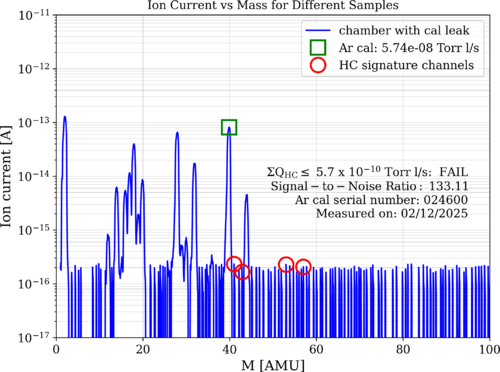
|
|
522
|
Mon Feb 24 17:50:13 2025 |
Luis | Update | VAC | RGA Scan |
| [Ma, Luis]
February 24, 2025 - 1:00PM
Ma performed an RGA scan with the vacuum system containing the heater elements. The results are attached below.
|
Pressure (Torr) |
Temperature (°C) |
| RGA Volume |
3.31 × 10⁻⁹ |
25 |
| Main Volume |
5.75 × 10⁻⁹ |
24 |
|
| Attachment 1: 2025-2-24_HeaterElement_ArO.png
|

|
|
651
|
Wed Oct 8 14:45:12 2025 |
Xuesi Ma | Infrastructure | VAC | RGA Chamber Pressure |
| RGA Chamber pressure is currently at 3.68e-4 torr. |
| Attachment 1: 20251008_130141.jpg
|
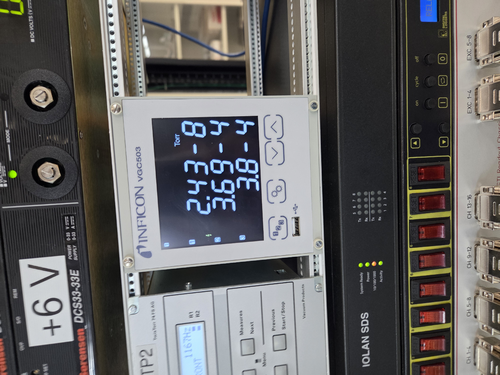
|
|
469
|
Wed Nov 6 13:48:55 2024 |
Liu | Update | Interferometer Simulations | QN modeling update |
| Slides |
|
405
|
Mon Jul 15 13:30:49 2024 |
Luke | Update | VAC | Problem with 2.75" to 1.33" zero length reducer |
| Last Friday while checking the depth of the ZLR I got one of the screws stuck. Today I tried a couple things to get it out. First I tried a few different pliers to be able to grip lower on the screw this didn't work. So I switched to the other method of drilling a small hole to see if maybe the threads would pull away from the walls of the hole a bit. This kind of worked as seen in the picture below I was able to remove most of the screw but there is a bit still stuck which I was not able to remove and I didn't want to use a larger bit for fear of damaging the tapped hole. |
| Attachment 1: IMG_1882.jpg
|
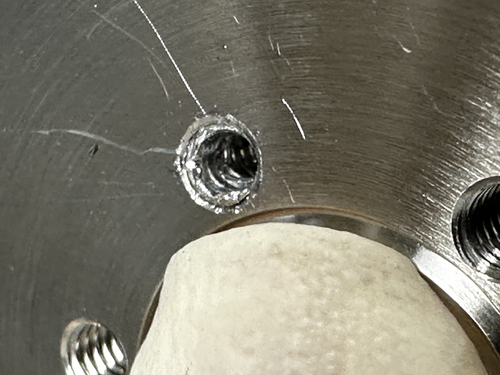
|
|
555
|
Thu Apr 17 12:12:29 2025 |
Liu | HowTo | Interferometer Simulations | Preventing Thread Contention in Multiprocessing with Finesse and Cython |
Avoiding Thread Contention When Using Multiprocessing with Finesse and Cython
When running Monte Carlo simulations or other computational workloads, it's common to use Python's ProcessPoolExecutor to parallelize multiple independent tasks. This approach works well—until it interacts with low-level libraries that themselves use multi-threading under the hood.
The Problem: Thread Over-Subscription
In a recent project, I ran into a significant performance issue while executing a large number of Monte Carlo trials using a process pool with 30 worker processes on Megatron (with 48 cores). Each trial ran a function that internally used cython.parallel.prange for fast, element-wise operations, which is what Finesse uses under the hood for many internal numerical calculations. Cython, via OpenMP, was configured to use all available CPU threads per process by default.
This resulted in severe thread over-subscription. With 30 parallel processes and each process attempting to use all 48 threads, the system was launching over 1,400 threads concurrently. The CPU quickly became saturated, and the tasks stalled. In some cases, the system became unresponsive, and the jobs had to be canceled repeatedly.
This happens because when the function calls into these libraries from within a Python multiprocessing context, each subprocess will attempt to use the full number of threads available to the machine.
The Solution: Limit Threads per Process
The solution is simple: explicitly limit the number of threads each subprocess is allowed to use. This can be done by setting the environment variable at the top of your script, before importing any thread-hungry libraries like Finesse.
import os
os.environ["OMP_NUM_THREADS"] = "1"
By setting OMP_NUM_THREADS to "1", we ensure that each multiprocessing worker uses only one thread internally, preventing them from overloading the system and allowing the tasks to run more efficiently.
|
|
653
|
Fri Oct 10 14:40:23 2025 |
Xuesi Ma | Update | VAC | Pressure gauge Swap |
| [Tyler, Ma]
We are suspecting a pressure gauge problem. The electronic unit of the main chamber pressure gauge and the electronic unit of the RGA chamber pressure gauge are swapped. |
|
535
|
Mon Mar 10 17:03:52 2025 |
Shane | Update | CDS | Pressure Gauge successful connect |
| Vac system serial interfacing update: the pressure gauge is now able to communicate successfully through the code. It's been set to a static ip of 192.168.1.30, on port 8000. |
|
255
|
Mon Nov 6 11:29:24 2023 |
Tyler | Update | Electronics | Preliminary RTD Calculations, RP Software Update |
Preliminary RTD calculations are shown below, given an input of 10 V and desiring a few mA of current. It looks like R_ref should be at least 1 kOhm (refer to plots/circuit below), keeping in mind we need to have <10 V input for the ADC.
RP: The Red Pitaya Software was updated to OS 2.00. All examples on the RP website should run without issue. |
| Attachment 1: cvt.png
|

|
| Attachment 2: VvC.png
|

|
| Attachment 3: IMG_7471.jpg
|
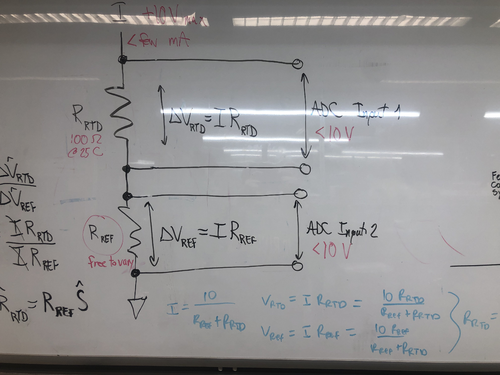
|
|
185
|
Tue Aug 1 12:48:41 2023 |
Aiden | Update | Cleanroom | Pre Filter Change |
Changed the pre filter inside of the 3 stage HEPA system next to the soldering station. It was rather dirty and I have attached images with a clean filter on the left and the used one on the right. I reset the pre filter age on the system. I tried to see if I could tell if the HEPA filter was dirty but I could not see it. I did not reset the age of the HEPA or UV stations. They are currently 378 days old.
|
| Attachment 1: IMG_4564.jpg
|
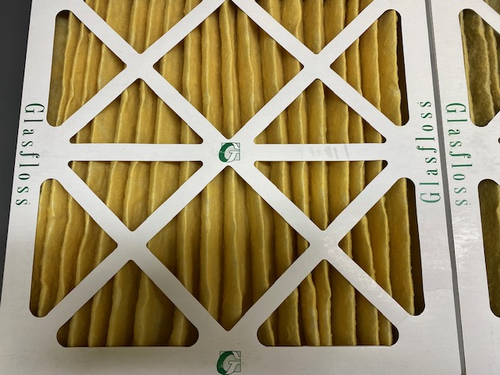
|
| Attachment 2: IMG_4563.jpg
|
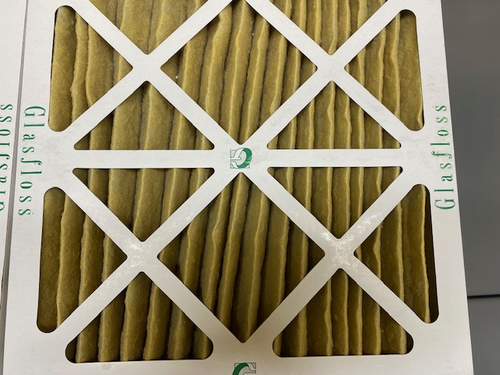
|
| Attachment 3: IMG_4562.jpg
|
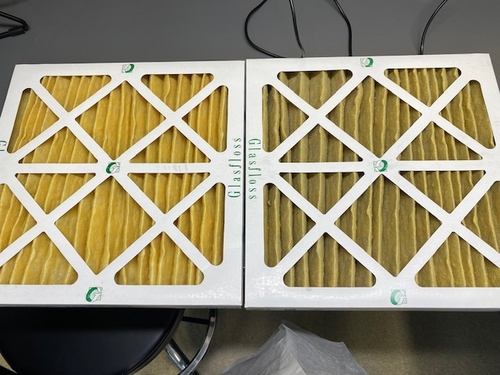
|
|
137
|
Wed Jun 28 15:58:56 2023 |
Shane, Cao | Infrastructure | VAC | Power trip problem remains, source of smoke is insulation |
| [Shane, Cao]
With the new change in wiring configuration described in elog 136, we tried to power up the heaters for baking the vacuum chamber again.
Given that we were worried about the turbo pump overheats, we set the setpoints of of bother high temperature controller and PID controller to be 120 deg C before turning the heaters on
1. Evidence of smoke originating from CoolSkin insulation
We then removed most of the CoolSkin insulation on the Pump and RGA lines ( apart from the one around the flexible bypass line connecting the two ) (see image Pumpline_afterRemoveInsul and RGAline_afterRemoeInsul) .
Upon removal of the insulation, we noticed that the insulating foam melted onto the heating tape (see image MeltedInsulation1 and MeltedInsulation2). This is the first indication that the smoke had most likely coming from the insulating foam itself
Once we started baking, upon reaching 80 degree range. We observed no smoke at the location that we removed the insulation. However, We observed smoked coming from underneath the insulation around the flexible pipe, and not from the velcro areas.
What could be causing this, given that the maximum operating temperature of the insulation is 200 deg C? Most likely, the heating tape is much hotter than we think it is. But given that the temperature sensor readout is much lower than 200 deg C, it's likely that this is due to poor thermal contact and it takes a while for sensor to reach a thermal equilibrium with the heating tape. Here, I suggest we should implement the following:
- We should look into usingsome form of thermal tape (if possible to secure the temperature sensors)
- Unfortunately or controller does not allow programming process, we will have to implement manual temperature stepping, emulating ramping process over the first hour, until slowly reach 120 deg C
- OR Tune the PID controller coeffs, especially P and I for longer rise time and settling time
2. The heaters still trip our power
Upon reaching 80 deg C,our main power trip. Unfortunately I don't know how to reset this. Do we need to contact facility on this? Reading elog 136, I noticed that both controllers are connected to the same circuit LP3B 6, which is the same circuit the some of the fan-filters and LED light panels of the cleanroom connected to. From the elog, the circuit has a 20 A limit . An max operation, the 2 heater controllers draw 30 Amps, approx 7 Amps for the fan-filters, and another 1.5 A for LED panel. The combination of these equipment must have overload the circuit and tripped it . Currently half the fans + lights are off in the cleanroom are off due to power trip. Here, I would make a suggestion that each heater controller should be connected to a separate circuit . Currently we LP3B 7 (same side next to LB3B 6) and LB3B 4 (opposite side of the rail) having no equipemts connected to them, but will require cable extensions. |
| Attachment 1: Pumpline_afterRemoveInsul.jpg
|
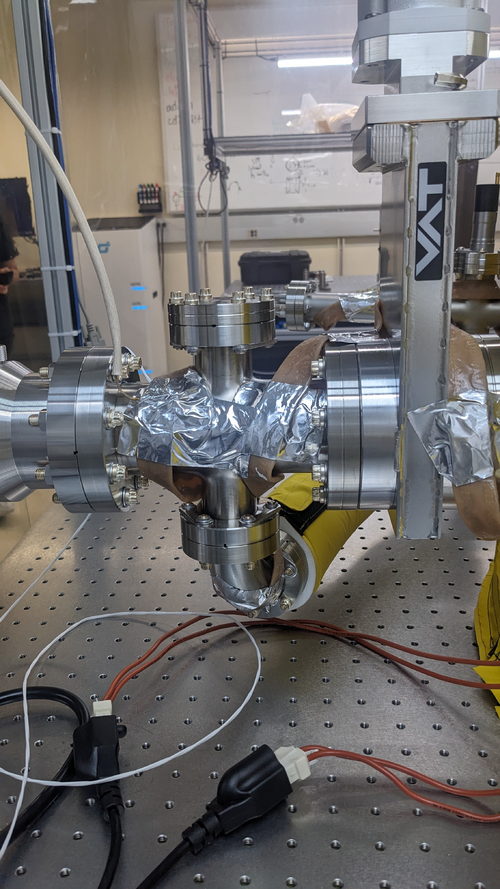
|
| Attachment 2: RGAline_afterRemoeInsul.jpg
|
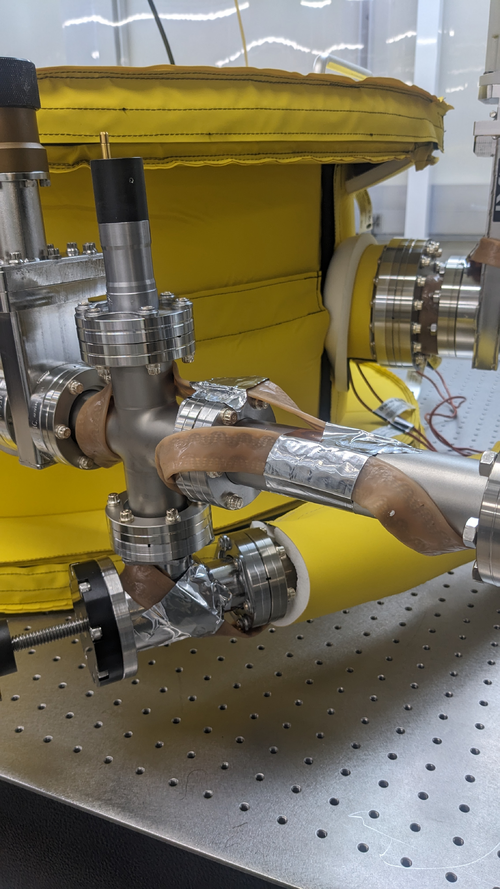
|
| Attachment 3: MeltedInsulation1.jpg
|
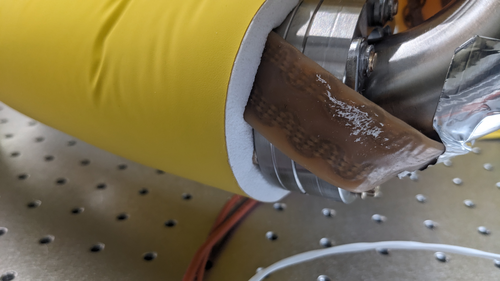
|
| Attachment 4: MeltedInsulation1.jpg
|

|
| Attachment 5: MeltedInsulation2.jpg
|
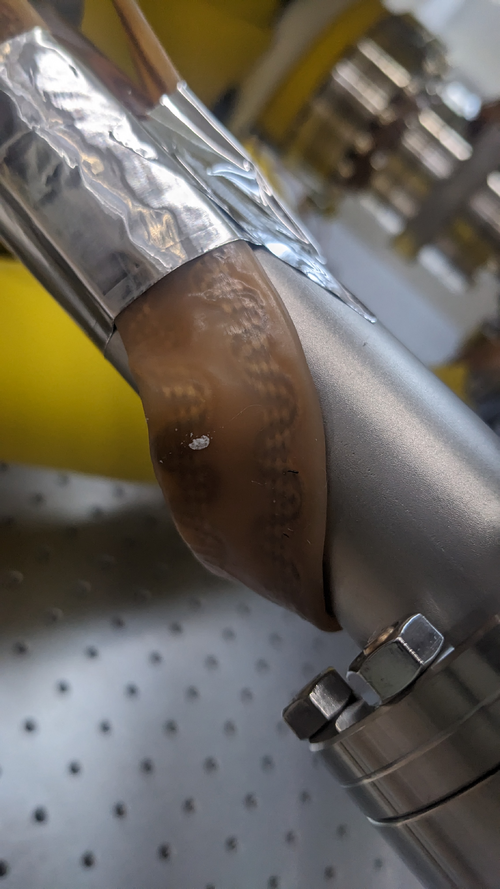
|
|
330
|
Tue Feb 20 08:01:30 2024 |
Jon | Infrastructure | General | Power and network equipment installed in 1129 rack |
| [Jon, Tyler, Pooyan, Luis, Luke, Peter]
On Thursday we installed the power conditioning/distribution equipment and networking equipment in the new 1129 rack. The hardware is identical to the setup in the 1119 rack and includes:
- Tripp Lite SU5KRT3UTF - 208V, 5kVA on-line UPS with 120V transformer
- CyberPower PDU20M2F12R - metered power distribution unit, (14) NEMA 5-20R
- Ubiquiti USW-Pro-48 - 48 port 10Gbps network switch
The UPS is connected to a 208V NEMA 6-30R outlet in the overhead cable tray, which is on the building's "standby" (backup power) circuit. An 8-ft L6-30 extension cord has been ordered to permanently run the power cable through the cable tray.
The network switch will be connected to a Cat6 cable that was recently run by ITS from the 1119 rack, allowing the lab's LAN to be extended into 1129. This Ethernet link remains to be tested.
| Quote: |
Server Rack Installation
A new Tripp Lite 42U open-frame rack was laid in place in 1129 and anchored to the floor (see attachment 1). This rack will house all of our general-purpose and simulation computers, which will be relocated from the 1119 rack at a later time.
|
|
| Attachment 1: IMG_0924.jpeg
|
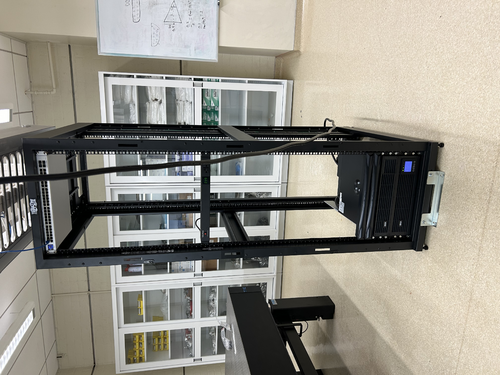
|
| Attachment 2: IMG_0925.jpeg
|
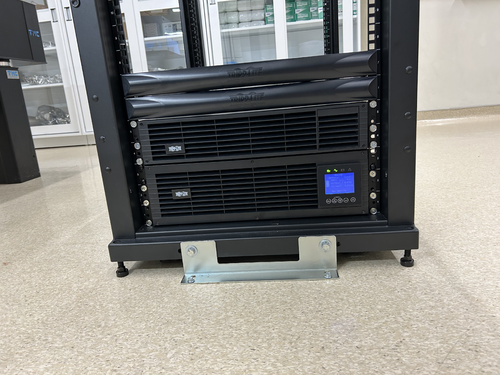
|
| Attachment 3: IMG_0921.jpeg
|

|
| Attachment 4: IMG_0922.jpeg
|
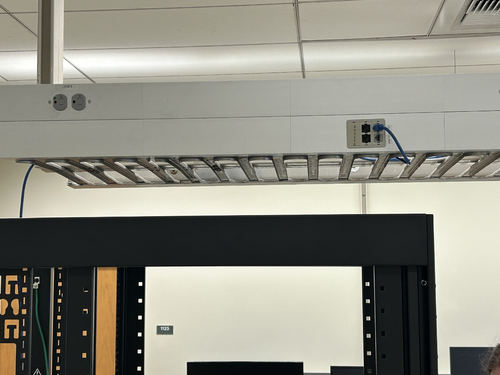
|
|
604
|
Mon Jul 7 16:39:18 2025 |
Christina | Update | TCS | Pomona Box Drawings |
Below are the drawings for the pomona box modifications |
| Attachment 1: pbdwg1.PDF
|

|
| Attachment 2: pbdwg2.pdf
|

|
|
587
|
Tue Jun 3 12:16:13 2025 |
Cynthia | Update | Interferometer Simulations | Point absorber simulation on radially averaged profile |
|
| Attachment 1: update_6_3.pdf
|

|
|
165
|
Tue Jul 18 16:35:06 2023 |
Pamella | Update | FLIR | Plot-Data with the new configuration without the mask and reflector. |
[Pamella]
- I was able to plot the first graph for a result between the six different positions on the screen, for now we can see the behavior of the heater temperature in a Gaussian graph with combination data between the six files.
- To do: Tyler gave me some ideas today to improve the plot. So I'm going to change the code to have insulation on the values for just the heater ("insulation") and I'm going to plot after this insulation data as well I'm going to get more data and compare with more data for the same position.
- I was using the data than I got last week and I shared on Elog (151) and we can see on this quote
| Quote: |
| [Pamella]
I started collecting data by moving the camera FLIR and covering all six positions on the screen (2x3). I was looking and taking snaps for more than one hour and a half. I'll repeat this one more time to make sure we have enough data to do analysis.
I attached snap data below. This images is processed on python code. |
|
| Attachment 1: Gauss.plot.jpeg
|
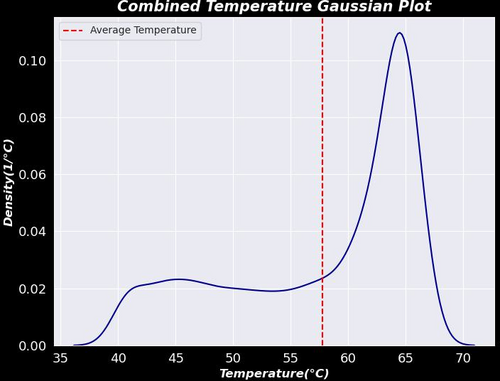
|
|
431
|
Thu Aug 29 16:39:34 2024 |
Luke | Update | VAC | Photos of heater tape |
|
| Attachment 1: IMG_2052.jpeg
|
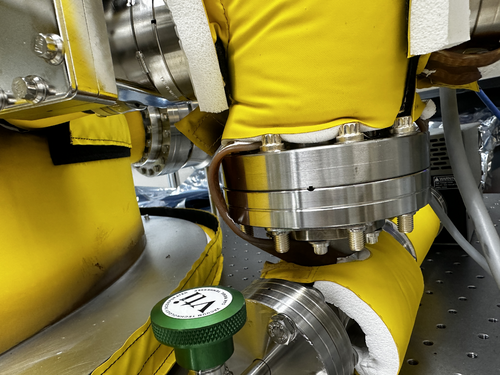
|
| Attachment 2: IMG_2051.jpeg
|
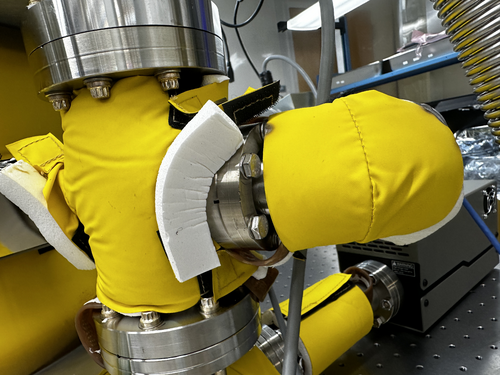
|
| Attachment 3: IMG_2048.jpeg
|
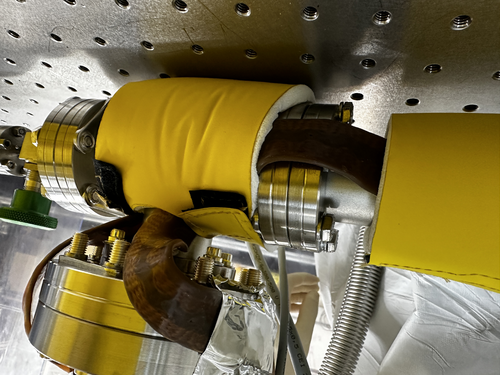
|
| Attachment 4: IMG_2047.jpeg
|
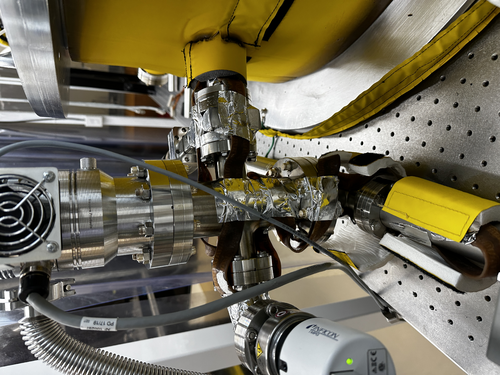
|
| Attachment 5: IMG_2046.jpeg
|
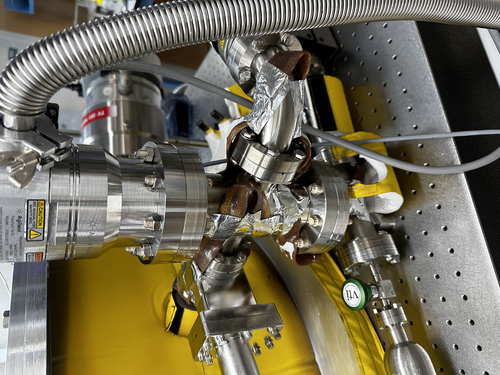
|
| Attachment 6: IMG_2044.jpeg
|
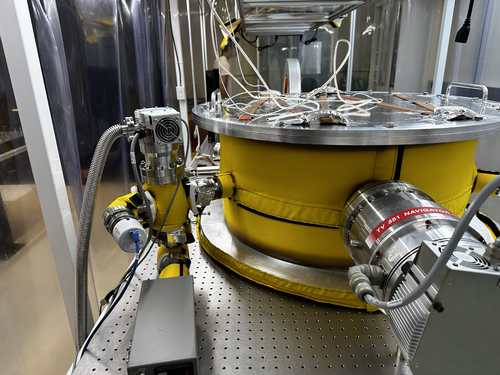
|
|
560
|
Tue Apr 22 13:00:04 2025 |
Nathan | Update | VLC Update | Photodiode signal check and additional signal check due to 20Mhz signal and amplifier |
| In general, photodiode was able to achieve signal. Below are the voltage signals and frequency measurements of the photodiode with the dc bias and amplifier connected to the EOM (Vpp = 2mV for first and Vpp= 1 for second). Also I need assistance in using the PZT driver. |
| Attachment 1: thumbnail_(8)_(1).jpg
|
_(1).jpg.png)
|
| Attachment 2: vpp.jpg
|
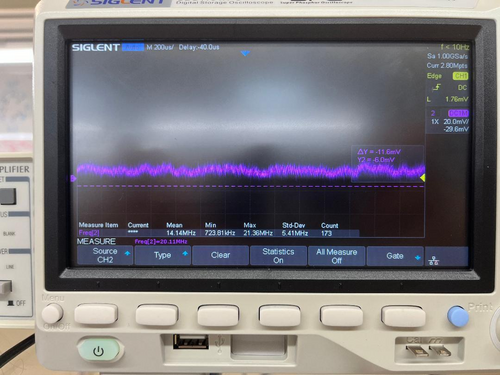
|
|
614
|
Tue Jul 15 13:13:48 2025 |
Christina | Update | TCS | Photodetector optical post assembly |
|
| Attachment 1: pdreassembly.png
|

|
|
94
|
Tue May 9 15:49:20 2023 |
Jon | Infrastructure | VAC | Permanent cable routing |
Today I brought in a fresh supply of zip ties (we now have 1500 in the tool chest) and used them to permanentize the cable routing for the gauges, pumps, and RGA.
I also brought and installed a 3-foot 15A extension cable for powering the scroll pump. Installing the cable required shutting down the pumps, which I did and then reverted via the following procedure:
- Close the 4.5" gate valve, 2.75" gate valve, and the bypass line angle valve.
- Shut down the turbo pump.
- Shut down the scroll pump.
- Unplug the scroll pump and install the extension cable.
- Power on the scroll pump.
- Power on the turbo pump.
- Open all three valves.
Incidentally, before I started, I noticed that the pressure in the main volume had reached 7E-7 torr, which is lower than the pressures seen last week. The system quickly returned to this pressure after I restarted the pumps. |
|
12
|
Mon Nov 28 18:10:23 2022 |
shane | Update | ELOG | Particle counts in the clean room |
| Particle count stats for the clean room Nov 28, 2022:
Took 10 sample runs in each of 5 regions in the clean room (5 runs per region with a person inside the clean room for the measurement, and 5 runs per region without anyone in the clean room for the measurement), for a total of 50 samples taken. Sample time was 60 seconds. Overall clean room average particle count for the size ranges are as follows:
0.3 micrometers- 3405.76 (room occupied), 974.92 (room empty)
0.5 micrometers- 409.72 (room occupied), 409.72 (room empty)
1.0 micrometers- 1102.2 (room occupied), 282.6 (room empty)
2.5 micrometers- 692.32 (room occupied), 183.68 (room empty)
4.0 micrometers- 254.28 (room occupied), 84.72 (room empty)
5.0 micrometers- 141.24 (room occupied), 84.72 (room empty)
7.0 micrometers- 56.48 (room occupied), 84.72 (room empty)
10.0 micrometers- 42.36 (room occupied, 42.36 (room empty)
More statistics (including individual stats on the 5 regions within the clean room) attached. |
| Attachment 1: clean_room_particle_counts_11_28_-_Sheet1.pdf
|

|
|
64
|
Tue Apr 4 16:52:08 2023 |
Jon | Update | Cleanroom | Particle counter docking station |
| Due to the problems we have encountered trying to serially communicate directly with the Met One DR-528 particle counter, I went ahead and ordered the add-on communications/charging dock. The dock "ethernetizes" the serial communications by wrapping them in TCP packets and transmitting them over the lab network. This will allow our Python code to communicate using the standard Internet sockets package, rather than PySerial, PyNut, etc.
the docking station arrived today and I delivered it to the lab. I left it laying next to the particle counter in the electronics rack. |
| Attachment 1: Met_One_Dock.png
|
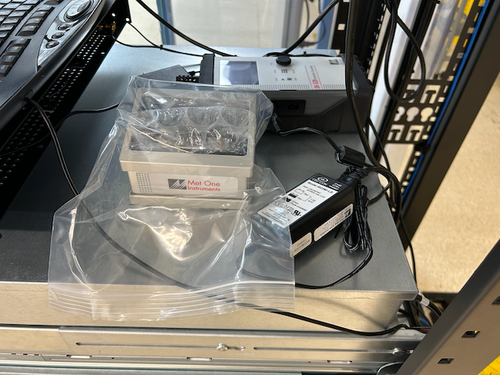
|
|
71
|
Wed Apr 12 16:17:50 2023 |
shane | Update | General | Particle Counter moved |
| With the added height of the new docking station, the particle counter no longer fits under the Windows monitor in the electronics rack and has been moved to the desk in the corner of the lab. |
| Attachment 1: IMG_6693.HEIC
|
|
235
|
Mon Oct 9 11:29:37 2023 |
Tyler | Update | Electronics | PSD/CSD Plot Updates |
| Continuing from Sophia's SURF Project this summer: Plotting the Power-Spectral Densities (PSDs) and Cross-Spectral Densities of two signals.
A continued issue that has been observed in the plots is the random "jump" of one PSD curves. Below, a 1.4 kHz signal is driven with a magnitude of 0.7 Vpp, and connected to the two output ports of the Red Pitaya via an SMC T-Adapter. At the moment, I anticipate that this bug might have something to do with the Real-Time GUI code being used, since this hasn't been observed when running the calculations without it (see below). |
| Attachment 1: Screenshot_2023-10-09_at_11.20.25_AM.png
|

|
| Attachment 2: welch_csd-2.png
|
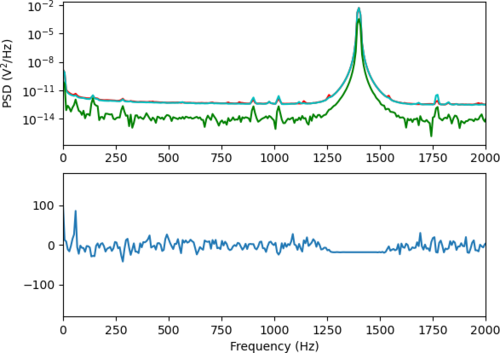
|